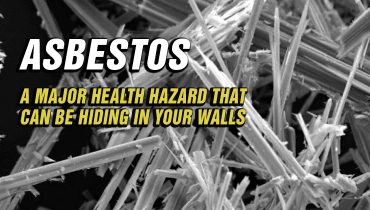When it comes to homes, water is enemy number one, and these 3 exterior home maintenance tasks will help prevent water damage. Water damage is one of the most costly...

How To Improve Well Water Quality
By Mike Holmes
Mike’s Advice / Home Safety & Maintenance
Thursday, February 18th, 2021 @ 2:40pm
Protecting Your Health: Tips For Improving Your Water Quality
If you’re like me and live in a rural area chances are you are on a private well system, meaning, you are not connected to your local water system. It also means you are responsible for the health and safety of the well. The well water is groundwater that is untreated and comes from the aquifer, which is an underground layer of permeable rock containing water. This water is then pumped up from the ground and into your home. Depending on where you live most well water tends to be “hard”.
What does hard water mean?
When your water is “hard” it contains a high concentration of mineral deposits, mostly calcium and magnesium. Over time these deposits can accumulate, clog, or even corrode pipes and cause major plumbing problems.
Hard water deposits can build up in boilers and water heaters, making them less efficient and more expensive to use. Hard water deposits can also build up in your plumbing fixtures, like faucets and showerheads too – it’s that white scaly substance. Often, hard water doesn’t completely rinse the soap, shampoo or detergent from your hands, body, hair or clothing, leaving you and your hair with a tacky, sticky feeling or with clothes that are stiff or dull. This same soap buildup can be seen as a bathtub ring or film on shower doors too.
How Do You Know If You Have Hard Water?
To properly determine whether or not you have hard water, it is best to get a proper water test done by water professionals, like Kinetico. It may also be helpful to have your TDS levels tested, which is Total Dissolved Solids. TDS levels indicate the total amount of dissolved inorganic and organic solids in water. Having a high TDS level indicates that you likely want a water filtration system installed to filter out all of these contaminants.
If it’s indicated that you have hard water as well, then you would also need a water softener installed as part of the water filtration system —and let me tell you I had very hard water and had to replace my water heater due to excessive scale build-up which wasn’t cheap. So this is something that you want to pay attention to.
The well water can also have a sulfur smell – like rotten eggs and a funny taste. It can also cause stains. Have you ever seen orange rust coloured streaks in a toilet bowl? That is from the high iron content in the water.
RELATED
How To Improve The Quality Of Your Well Water?
One solution to having hard water is to install a water softener. A water softener is an ion-exchange filtration system that removes high levels of calcium and magnesium from the “hard” water. By removing the minerals the water becomes soft, and in turn will also reduce that scale buildup in your pipes, and reduce the staining you see from iron and manganese.
Having soft water can help extend the life of your appliances, such as your washing machine and dishwasher.

Not only do these systems improve the quality of your water, but you will even be able to taste the difference.
However, if you want good-tasting water for drinking and cooking and you’re using a water softener, you may want to consider investing in a drinking water filtration system. Kinetico has a number of options, including my favourite the reverse osmosis system.
A reverse osmosis system reduces trace elements, heavy metals, and bacteria. Reverse Osmosis systems are available in whole-home or under-sink models. Make sure you get a model that meets your demand and remember maintenance is required with regular filter replacements.
RELATED
How Do I Know If I Have A Problem With My Water And What Should I Do?
I would recommend getting your water tested by water professionals. Depending on the results of your water test, they may recommend you get installed a whole house water filtration system, which is comprised of the above units, to ensure that every drop of water that flows through your home is clean and worry-free.

Mike Holmes tested his water sample with Kinetico’s water experts.
Almost all water treatment systems are self-cleaning and must have a specific minimum flow rate, but it’s important to choose a water treatment system that works with your well water pump. For optimal performance, it is important that these two systems properly align.
The flow refers to the amount of water coming from the well and the flow rate measures the gallons per minute being dispersed. The average home needs 100 to 120 gallons per person per day and a flow rate of about 6 to 12 gallons per minute. Most wells in Ontario must have a minimum of 3 GPM but average between 5-6 GPM. This amount should be sufficient to meet the needs of an average family.
You’ll need to figure out what the water pressure from the well water pump is, before picking a water treatment system. If you don’t the result will be reduced water pressure in the home.
Did You Know You Can Have Radon in Your Well Water?
Because the water comes from deep underground, well water can become contaminated. Naturally, occurring contaminants can include uranium, arsenic, and radon, which dissolve into the groundwater as it moves through soil and rock. The well water can also be contaminated by agricultural runoff. Your well water can also contain high levels of radon gas!
When radon gas dissolves into well water, every time you shower, wash clothes or even run the tap, you’re releasing this gas into your home. Even drinking radon-contaminated water could lead to higher instances of stomach cancer. Radon is the number one cause of lung cancer in Canada for non-smokers and everyone should be aware of the potential harm from this deadly gas.
How Do You Mitigate Radon In Well Water?
To protect yourself from radon entering your home through your well water, I suggest installing an aeration system. The technology found in the Airwell is great —we had installed in our home.

The Airwell mitigates the radon right in the well before it enters your pipes.
The Airwell injects air into the water source through an aeration pipe resulting in improved water quality. With a pressurized air pump at the base of the well, contaminated water is lifted to the surface. The system is automatic, maintenance-free with minimal operating cost. There are also no chemicals used. Airwell releases excess iron, manganese, hydrogen sulfide, methane, carbon dioxide, and radon into the air.
Generally, the best way to ensure your water sample is able to be tested properly is by taking your sample on a Monday and shipping it overnight to the lab so it arrives Tuesday for prompt testing.
RELATED
Monitoring Your Well Water
It’s important to get your well water tested every two years or more. This is especially important if you notice any changes, particularly in taste, smell, colour. Keep an eye out if the surrounding land has been altered, such as a major construction project, near your well. It’s the law in Ontario to keep a log or record of the well’s history. This will be an asset when you decide to sell your home but also good practice in the maintenance of your well.

When you test your well water for radon – you must send in the results quickly.
A log will identify how big the well is, what has been done to the well in the past when it was tested, how much the well holds, and the flow rate. This is all important information to have on hand. Water testing includes PH, hardness, alkalinity, and turbidity (cloudiness). Standard mineral testing will often include things like iron, calcium, manganese, copper, fluoride, chloride, and others. However, bacteria and nitrate testing should be checked annually in rural areas.
You may also want to check for VOCs. The most common VOCs come from gasoline, benzene, and other solvents. Make sure the samples are tested through an accredited laboratory in your region.
RELATED
What happens if you require a new well?
A properly maintained private well should last anywhere between 30-50 years but what happens if you need a new well? You basically have two options. The first is to drill a new well. The other is to increase the yield of your existing well by a method called hydrofracturing or hydrofracking.
Generally, the golden rule about wells is that the deeper the well, the better the water quality. According to code, a new well must be at least 6 metres deep (20 feet). However, if the only useful source of groundwater is less than 6 metres below the ground surface, the well must be at least 3 metres deep.
Hydrofracturing involves injecting water at high pressure into the well and the rock formations surrounding it. The point of hydrofracturing is to widen or extend the blocked network of fractures in the bedrock creating a larger area of water supply to the well. This method of well water stimulation is a cost-effective way of increasing the yield of an existing well or an older well with low water levels.
Another thing to note is that if you have a well then you have a septic system. A septic system processes the waste produced by the home. Nothing lasts forever but certain parts, like a pump or well pressure tank, may need replacing.
Remember, the well and the septic system should be at least 100 feet apart. Also, tanks should be inspected regularly and pumped every 3-5 years as required.
RELATED
KEEPING YOUR SEPTIC SYSTEM IN TOP SHAPE TO MANAGE WASTEWATER








